Heating system leningradka: connection, features, advantages
The heating system of a private house Leningradka is one of the most reliable and easy to do-it-yourself solutions. We will talk about the features, advantages and ways to connect this heating system.
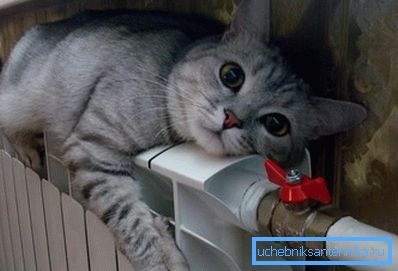
One-pipe heating system (Leningradka)
Definition and composition
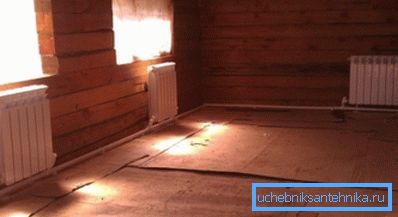
Leningradka is the name of a one-pipe coolant circulation system in the heating circuit of a house. In this case, radiators or batteries are connected in series, and water moves in a closed loop:

The figure shows the main nodes:
- Boiler water heating. There are gas, wood, peat, solid fuel, electric and gasoline units, most often use gas heating boilers;
- Nozzle for removing air and draining water from the expansion tank. The presence of such a nozzle indicates an open type of heating, in which excess water is removed without creating pressure; (See also the article Airing the Heating System: Features.)
- Expansion tank. Designed to adjust the pressure by accumulating water during thermal expansion and recoil during cooling. In the event of an accident and overheating / boiling up of the coolant, it plays the role of emergency discharge of water;
- Circulation pump. Provides the necessary pressure and rate of circulation of the coolant in the circuits with forced circulation;
- Ball valve drain water. It is necessary to remove coolant from the pipeline and radiators for the period of repair or to preserve the heating circuit for the winter;
- Heated water supply pipe;
- Mayevsky's crane to remove excess air from the radiator;
- Radiator or battery;
- Pipe exhaust coolant (obratka);
- Sewage drain for disposal of water removed from the main line;
- Ball valve connecting to the water supply. When it is unlocked, the circuit is filled with water, then the faucet is locked and the heating is started;
- Filter for water purification before feeding into the pipeline;
- Ball valve to turn off the radiator. Allows you to turn off individual batteries for repair or to save energy;
- Bypass or bypass. Allows you to adjust (if a needle valve is installed) or cut off one or another radiator from the common circuit.

The heating system of the closed type assumes the presence of an expansion tank without an outlet. Such heating works under pressure, and for emergency operation protection is provided in the form of a simple structure:
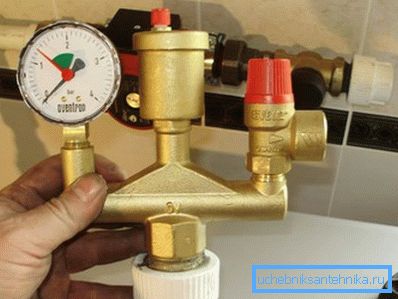
Note! The one-pipe solution assumes a consistent arrangement of heaters on a common highway or riser. This allows you to save on pipes and installation activities.
Species
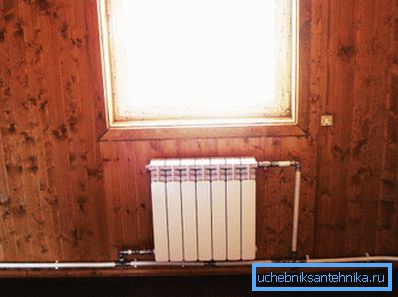
In addition to the division into closed and open species, Leningradka differ in the type of wiring into horizontal and vertical types.
The horizontal scheme of heating in a private house is most preferable. It involves the laying of the highway along the contour of the room along the external wall in the thickness of the floor or above its surface. Radiators are connected in series to the main line:
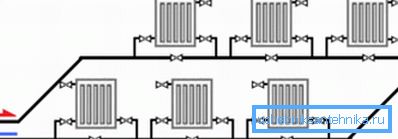
Note! It is desirable to make one circuit, while the number of radiators in the circuit should not exceed 10 pieces. When connecting two circuits of different lengths and heat transfer, their throughput should be regulated with needle valves so that there is no imbalance of the system.
In case of vertical distribution of pipes, heating devices are connected in series to the common riser. In such cases, as a rule, forced circulation and the upper water supply are used.
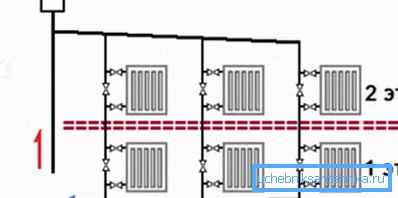
Note! As you can see, with vertical wiring, a parallel connection of several single pipe chains to a common riser is most often realized. This is convenient for high-rise buildings.
Advantages and disadvantages

If we talk about the advantages of single-pipe heating, then they mainly rest on economy and reliability:
- Single tube contour implies less consumption of the pipe, therefore, the cost of the project decreases;
- Assembly, welding and other related work with one pipe is noticeably less. It also allows you to save on labor remuneration and energy costs, time and consumables;
- The system is time tested and proved to be extremely reliable.;
- It is possible to hide the pipe under the floor. It should take into account the heat loss from the contact line with the floor structures and make appropriate thermal insulation;
- The presence of bypasses allows you to repair appliances in the operation of heating, and also to regulate the intensity of work of individual batteries and premises.
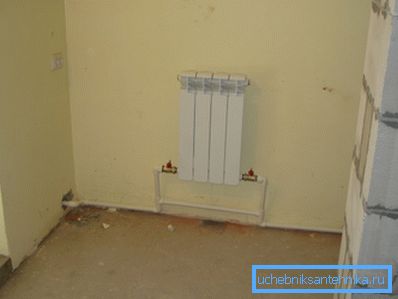
The disadvantages of Leningradka include its qualities:
- The need to comply with the correct ratio of the diameter of the pipeline, a large cross-section of the main pipe;
- Uneven heating of radiators depending on their removal from the boiler. To equalize temperatures, it is necessary to increase the size and number of battery sections as it moves away from the heat source;
- Due to the uneven distribution of heat, it is not recommended to connect more than 10 radiators into one circuit, so this solution is only suitable as heating a private house - it’s the easiest to implement with your own hands.
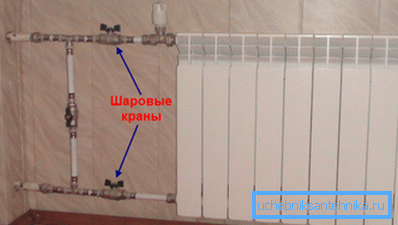
Note! From an analysis of the advantages and disadvantages of a one-pipe heating scheme, it can be concluded that it is suitable for private and small communal houses.
Conclusion
Leningradka allows you to easily and inexpensively arrange heating in a private house. It is characterized by flexibility and the ability to adjust the heat transfer intensity of individual heating devices. For a more complete experience, watch the video at the end of the article.